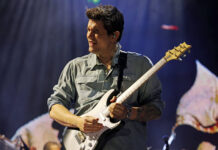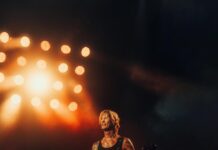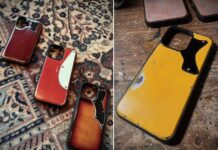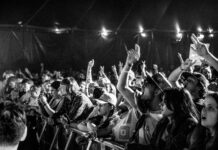
The Guitar Gear Used on The Foo Fighters landmark The Colour and the Shape
The Foo Fighter’s second album, The Colour and the Shape was a pivotal point in the career of the band. Through a turbulent recording process that forever altered the lineup of the band, it sent the Foo Fighters flying high with their first Top 10 album, their biggest hit song, and significant radio play. In this article, we’ll look at the gear that was used to record this landmark album (twice…).
For those unfamiliar with this era of the Foo Fighters career, it was one of unrest in the band. That unrest is laid out quite well in the documentary Back and Forth. The band recorded tracks for their second album at Bear Creek Studio in Washington. After that Grohl went to Hollywood to mix the record but discovered that he wasn’t happy with the sound, so he decided that he would re-record many of the tracks, including all of the drum tracks, which resulted in the departure of William Goldsmith and the introduction of Taylor Hawkins.
The Essentials – Guitars
I recently spoke with Dave Grohl’s guitar tech, Earnie Bailey, who was kind enough to look through his notes of the gear that was sent to Bear Creek Studio in Washington for the initial recording sessions. However, a lot of that gear was left behind when Grohl moved the sessions to Hollywood, California.
The guitars present at the Bear Creek sessions included some oddities, but we are unsure if they were used on the final tracks. Some of those included a Roland Synth guitar, an old Silvertone model from the 1960s that had an amplifier built into the case – these were really cool. They were only made for seven years (1962-1968), and they came in one and two-pickup versions. There was also a Mosrite 12-string, and two Travis Bean models (on Standard and one Artist) – only 755 Artist models were ever made. Both would have had the aluminum necks. A Telecaster Thinline was also present. The acoustic on those sessions was a Gibson (unsure of the model).
There are six guitars that we know made it to Los Angeles to be used on the tracks recorded at Grandmaster Studio in Hollywood. A Gibson Barney Kessel, a Gibson Les Paul P90 Goldtop, a Gibson Trini Lopez, a White Gibson Les Paul Custom, and a Hagstrom HiiN with a blue metalflake finish. Grohl also had a black 1990 Gibson Explorer that Earnie Bailey bought for him in Austin, Texas, in September of 1995. Bailey added chrome pickup covers and Gibson reflector knobs to it so it would be styled after a 1963 model. That guitar became his primary instrument through most of 1996.
Dave Grohl primarily used the Gibson Trini Lopez – he claims that this has been his secret weapon in the studio for much of his career. He got his first one, a 1967 model, back in 1992 when he was still with Nirvana. He also used the Les Paul Goldtop with the P-90 pickups. Given Pat Smear’s affinity for Hagstrom guitars, we can assume that he used the HiiN as his weapon of choice. We were also able to confirm that he had in the studio a Super Swede as well as his alpine white 1977 Gibson EDS-1275 SG Double Neck.
Grohl and Smear probably didn’t know it at the time, but they were both playing guitars in that studio that would later be the basis for signature models. Dave Grohl’s Gibson DG-335 was heavily based on his beloved Trini Lopez model. Pat Smear’s history with the Hagstrom HiiN model goes all the way back to 1980 when he was with The Germs. He used them all the way through his time with Nirvana, amassing quite a collection of them, I’m told. He now has a beautiful signature model from Hagstrom that is heavily influenced by the HiiN models.
Make It Loud – The Amps
Dave Grohl played the bulk of his guitar tracks through a Fender (Zinky) Custom Shop ToneMaster 2×12 100-watt amp. The Fender Zinky was an amp that was present at the studio. Grohl would eventually buy three ToneMaster heads in 2000 that he still uses today. For those unfamiliar with “Zinky” amps, they were amps built in Fender’s Custom Shop by a guy named Bruce Zinky starting in the early 1990s. He eventually made his own company, Zinky Electronics, and eventually bought the Supro brand.
In addition to the Fender Zinky ToneMaster, there were some additional amps that we know were at the original Bear Creek sessions. Those amps were a Marshall ‘77-78 JMP 2204 50 watt head, a Marshall 1968 Super Bass 100watt head, a late 80’s or early 90’s Vox AC30, a 70’s Kustom K250 head, an Ampeg VT-22 combo, and a Mesa Boogie Studio .22/Crest 4801. It seems most likely that Pat Smear was using the Mesa Boogie Studio .22 preamp along with the Crest 4801 power amp as that is what he had been using at Nirvana’s live shows. His rig mirrored Kurt Cobain’s rig during the In Utero days as well.
The bass rig on the album was straightforward – Nate Mendel used a Candy Apple Red Fender P Bass through an Ampeg SVT. The P Bass is something that has been part of Mendel’s rig since he was in Sunny Day Real Estate. I believe that Mendel’s bass is a 1971 model. In 2012, Fender graced Mendel with his own signature model, which mirrors this bass and only comes in one color – Candy Apple Red.
Effects
The effects that were sent to Bear Creek were as follows: ProCo Turbo Rat, ProCo Rat 2, Kay Fuzz, Jordan BossTone, Boss BF2 Flanger, Ibanez AD9 Delay, Ebow, Dunlop Rotovibe, Cry Baby Wah, Boss delay, DigiTech Whammy, DOD Gonkulator. We don’t know how many of these were used on those sessions or what made it to the Hollywood sessions, but it does give a pretty good rundown of the basic effects that would have been used on the early Foo Fighters records.
A Foo Fighting Legacy
The Colour and the Shape remains their best-selling album, in part, due to the success of the singles, Everlong, Monkey Wrench, and My Hero, all of which are still fan favorites. While the album’s recording process may have created some turbulence, it solidified the band’s signature sound – quite literally – three of the instruments on this record served as a basis for signature instruments that would come from three different companies over a decade later.
For those seeking the Foo Fighters sound, there really isn’t much of a secret to it. It’s not necessarily a band where people geek out about the gear. The sound is rooted in a Gibson humbucker sound running through a loud amplifier. It is loud, straight-forward rock and roll, backed by some of the most brilliant songwriting of our generation. That’s what makes the Foo Fighters the quintessential rock band of the 21st century.
The post The Guitar Gear Used on The Foo Fighters landmark The Colour and the Shape appeared first on Guitar.com | All Things Guitar.
Source: www.guitar-bass.net












